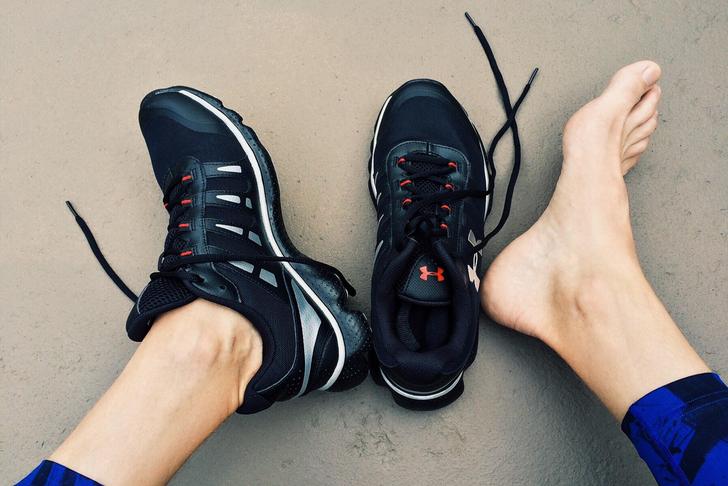10 plantar fasciitis symptoms
 Article Sources
Article SourcesPlantar fasciitis is a condition that affects the part of the foot that connects the heel bone to the toes.[[1]] It’s common in adults between the ages of 40 and 60, and it may be caused or aggravated by exercising on hard surfaces. Those who are overweight may also be at increased risk of developing the condition. In most cases, the symptoms of plantar fasciitis ease with rest. However, some people require physiotherapy or need to wear shoes with cushioned insoles to alleviate the condition.
Pain in the Bottom of the Foot
Plantar fasciitis refers to pain in a part of the foot known as the plantar fascia. This is the ligament that connects the heel to the front of the foot.[[1]] It supports the arch of the foot.[[2]] Pain that’s mainly around the heel and the arch of the food is likely to be plantar fasciitis. Fortunately, this pain is usually relatively easy to treat.

Advertisement
Pain That Worsens After Exercising
The foot pain from plantar fasciitis is usually a stabbing pain. It may subside during exercise and come back once you rest.[[3]] Some people report that they feel okay while sitting down, but when they get up in the morning or after a long period of sitting down, the pain returns. Walking on hard surfaces can make the pain worse. Thin-soled or poorly cushioned shoes can also aggravate the pain of plantar fasciitis.

Advertisement
Difficulty Lifting Toes
One of the less obvious symptoms of plantar fasciitis is difficulty lifting your toes off the floor.[[3]] This happens because the plantar fascia ligament links the heel to the front of the foot. Rest and gentle stretching exercises can help to restore strength and mobility. When the ligament heals, most people find they’re able to move normally again, and their toes become more mobile.

Advertisement
High Impact Exercise Can Cause Plantar Fasciitis
Many things can cause plantar fasciitis symptoms. The most common cause is repeated impacts or strain from work or playing a sport.[[3]] Running on hard surfaces or even standing all day can lead to plantar fasciitis. Ignoring the symptoms and continuing with the activity can increase the risk of heel pain becoming chronic. Prompt action to reduce the strain on the ligament helps promote healing.

Advertisement
Obese Adults Are at Increased Risk
Individuals who are obese are at increased risk of developing plantar fasciitis symptoms. This is because carrying extra weight puts more strain on the feet.[[4]] Rest and changing to footwear that offers better cushioning can alleviate the symptoms in the short term. However, for many obese or very overweight individuals, losing weight is a more effective long-term solution, as long as it’s done by following a nutritious and sustainable diet.[[5]]

Advertisement
Long Periods of Standing Can Aggravate Plantar Fascia
While impacts such as those sustained when running on concrete or exercising on hard wooden floors are more likely to cause plantar fasciitis, standing for long periods may also contribute to the issue.[[4]] Retail or customer service workers who are on their feet for long periods of the day may find it helpful to sit down during their breaks. They may also wish to choose shoes that offer cushioning and good arch support.

Advertisement
Rest Is the Primary Treatment
Most cases of plantar fasciitis get better within 2 weeks. Rest is the biggest factor when it comes to recovery, but changing footwear can also help.[[3]] Staying active during the recovery period is important. Some people opt to stop running or walking and change to swimming or other non-weight-bearing exercises that are lighter on the feet. Swimming offers a full-body workout and is a good cardiovascular exercise that doesn’t irritate the plantar fascia.

Advertisement
Cushioned Shoes May Reduce Pain
Unsuitable footwear can make many kinds of foot pain worse. Walking barefoot on hard surfaces can also cause or aggravate the condition. Treating plantar fasciitis by changing footwear is often effective.[[3]] High heels, pointy shoes and backless footwear, such as flip-flops or slippers, can irritate the plantar fascia. Wearing footwear that fits well and is properly cushioned while offering arch support helps reduce the strain on the plantar fascia.

Advertisement
Non-Weight-Bearing Exercise Can Help
While rest is helpful for many people, some individuals need physical therapy or other support. Stretching can help improve mobility and reduce pain.[[4]] Gentle exercise can help promote blood flow and may also benefit people with plantar fasciitis symptoms in other ways. For example, those who are overweight or obese may benefit from gentle exercise as a way to help them reduce their body weight and reduce the strain on their feet.

Advertisement
Painkillers Can Be a Short-Term Solution
Painkillers, such as paracetamol or ibuprofen, can reduce pain in the short term.[[3]] Follow the directions when taking these painkillers, and don’t take them for longer than necessary. Those who are taking other medications or who have a preexisting medical condition should talk to their doctor or pharmacist before taking any new medication. Always follow the directions when taking painkillers, including taking them with or after food if directed.

Advertisement





